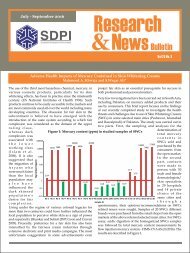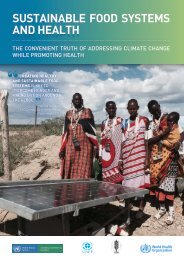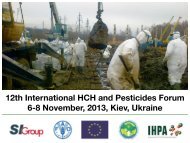Women and Chemicals
WomenAndChemicals_PublicationIWD2016
WomenAndChemicals_PublicationIWD2016
Create successful ePaper yourself
Turn your PDF publications into a flip-book with our unique Google optimized e-Paper software.
What are the main harmful substances that women are exposed to?<br />
Highly Hazardous Pesticides (HHPs)<br />
In the previous chapters highly hazardous pesticides <strong>and</strong> their<br />
effect on women, especially pregnant women, were already<br />
mentioned. <strong>Women</strong> working on small farms as well as women<br />
working in the agricultural industry, including in the flower industry,<br />
are exposed to these pesticides. <strong>Women</strong> ingest pesticides<br />
via contaminated food or via breathing when living close<br />
to agricultural sites. Pesticides are a growing issue of concern as<br />
the pesticides market continues to exp<strong>and</strong>. From 2009 to 2014<br />
the volume of sales of pesticides rose from 38 billion US Dollars<br />
to 52 billion US Dollars. In the future growth in pesticides sales<br />
is especially expected in Central <strong>and</strong> South America, Africa <strong>and</strong><br />
the Middle East. 9 These are all regions where women are highly<br />
engaged in the agricultural sector. For this reason the Latinamerican<br />
(GRULAC) region, among others, called in their recent<br />
SAICM resolution (August 2013) for the development of<br />
health risk reduction programs for vulnerable <strong>and</strong> at risk populations,<br />
including women. It also called for better protection<br />
from HHPs. Health problems for women caused by pesticides<br />
include acute poisonings (including deadly ones), uterine <strong>and</strong><br />
breast cancer, infertility, delayed menopause, <strong>and</strong> other diseases.<br />
Although some of the risks for women from HHPs are well<br />
known, there are few awareness-raising <strong>and</strong> capacity-building<br />
activities addressing women’s needs. Stricter laws that would<br />
phase-out HHPs <strong>and</strong> pesticides that contain endocrine disrupting<br />
substances, replacing them with safer alternatives, should<br />
be urgently implemented.<br />
Persistent Organic Pollutants (POPs)<br />
The Stockholm Convention bans POPs almost worldwide. At<br />
the moment the production <strong>and</strong> use of 25 chemicals (14 of<br />
them pesticides) is prohibited. This ban includes chemicals like<br />
lindane, PCB, endosulfan, aldrin <strong>and</strong> heptachlor. For DDT the<br />
use is severely restricted, <strong>and</strong> only allowed for malaria control.<br />
Many biomonitoring studies show that POPs can be found in<br />
human bodies, even some that have been prohibited for a long<br />
time. POPs accumulate in fatty tissue, <strong>and</strong> women generally<br />
have more of this than men. They enter <strong>and</strong> contaminate the<br />
foetus while it is still in the mother’s womb. Breast milk also<br />
contains POPs, so children are further exposed to them during<br />
nursing. However, breastfeeding is general the best option for<br />
the child.. 10 POPs are linked to many health problems that women<br />
suffer from: various cancers, neurological disorders, immune<br />
suppression, reproductive disorders like miscarriages, pre-term<br />
delivery, menstrual disorders, shortened period of lactation in<br />
nursing mothers, <strong>and</strong> other diseases like endometriosis <strong>and</strong><br />
type II diabetes. Since POPs are most harmful to the foetus, preventing<br />
exposure of pregnant women is critical.<br />
51







